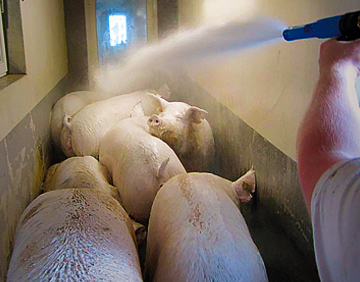Sow washing
During the long gestation period sows housed individually or in groups evidentially get dirty, especially at the backside, udder and flank area. Within this dirt and the in-the-skin flora, bacteria and viruses like Staphylococcus aureus, S. hyicus, Streptococcus suis, PRRS, coli bacteria, PIA, dysentery etc. can be present in huge numbers.
To protect the newborn piglets and give them a healthy start from day one, we cannot expose them to this high level of infectious pathogens. Washing the sows before they enter the farrowing house is a standard procedure at every sow farm which aims for maximum profit through maximum prevention.
Skin disinfection
On pig farms, skin disinfection treatment is still mostly applied sporadically on animals that are heavily injured on the skin, for example sows with a shoulder lesion or wounds after severe fighting. Of course in these cases they need treatment and skin disinfection is definitely an important part of that treatment.
However when skin disinfection becomes part of a total prevention protocol, the benefit for the farmers goes much further than aiding only one individual animal but prevents spread of disease among the whole herd through cross contamination like mange, streptococcus, E. coli, parvo, influenza, etc.
Disclaimer: not all CID LINES, an Ecolab company, products are available or registered in all countries. For information about availability of a specific product, please contact your CID LINES, an Ecolab company, dealer.
